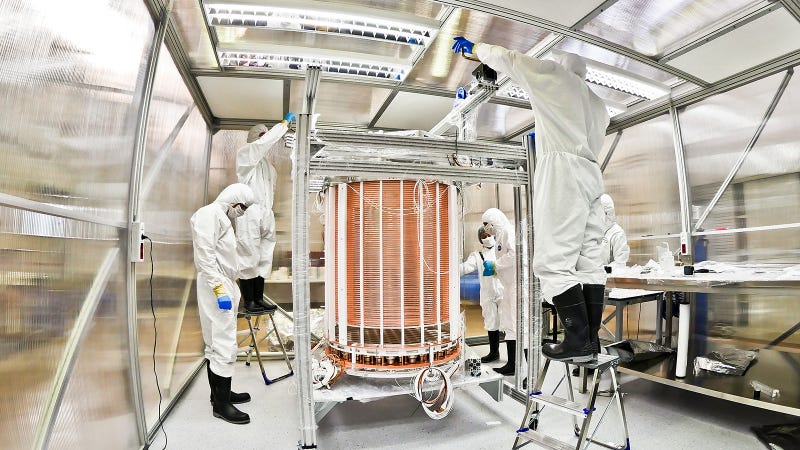
A detector designed to hunt for dark matter has made a particle physics observation that will hopefully help physicists establish important truths about our Universe. No, it didn’t spot dark matter, but the new result proves that these ultra-sensitive detectors are valuable to scientists for multiple reasons.
Gravity-wise, the Universe behaves as if it contains way more matter than astronomers have actually identified, so physicists have built experiments to hunt for candidates for this so-called dark matter. The hunt for the most popular dark matter candidate has so far turned up empty. But one of these dark matter experiments, called XENON1T, has now observed a process that has avoided multiple detection attempts, one that will hopefully help scientists better understand the shadowy particle called the neutrino.
“It proves that this XENON detector technology we use for dark matter is much more versatile,” graduate student Christian Wittweg, Ph.D student at the University of Münster in Germany, told Gizmodo. “We get all these cool analyses... for free after having built an experiment sensitive enough to hunt for dark matter.”
Scientists are pretty sure that the second most abundant particle in the Universe (after photons, particles of light) is the neutrino. But neutrinos are very hard to detect and measure. We know they have mass, but don’t know how much. We know that they have an antiparticle, a sort of evil twin that causes both particles to annihilate if they meet, but don’t know the nature of that antiparticle. There are a ton of neutrino mysteries to solve. The new measurement, called “two-neutrino double electron capture,” is an important stepping stone to providing those answers.
Two-neutrino double electron capture is an exceedingly rare particle interaction that was first theorized in 1955 and “has escaped detection for decades,” according to the paper published in Nature. In the process, two protons in the atomic nucleus spontaneously and simultaneously absorb a pair of electrons orbiting the nucleus, releasing a pair of neutrinos. The experimental signature of the event is a barrage of x-rays and electrons resulting from other electrons orbiting the atom replacing the two absorbed by the nucleus. And when I say rare, I mean rare. The average amount of time it would take half of the xenon atoms in a sample to undergo this reaction is 1.8 × 1022 years, according to the paper. That’s roughly a trillion times the age of the Universe.
Advertisement
XENON1T is an experiment perfectly equipped to measure this rare event. Firstly, it contains a crapload of xenon atoms—3.2 tons worth of liquid xenon (though, as a note, the xenon isotope used for this measurement makes up only a small fraction of the total xenon atoms). Secondly, the whole setup is buried deep within an Italian mountain, shielding it from pretty much any particle that could cause a false signal. And finally, scientists understand pretty much every bit of noise that could produce a signal in the experiment, increasing their confidence that they’ve actually found something important when an anomalous signal appears.
After 214 days of observing (177 days of usable data), the researchers’ analysis revealed approximately 126 two-neutrino double electron capture events.
This is an incredible scientific accomplishment. “It’s the longest half-life ever measured directly,” Ph.D student Chiara Capelli from the University of Zurich who works on XENON told Gizmodo
Advertisement
Researchers aren’t calling their results a “discovery,” because their statistics didn’t hit the five-standard deviation threshold particle physicists require in order to use that word. Instead, they’re calling it an “observation,” as the result carried a significance of 4.4 sigma. That means there’s only a one in a few hundred thousand chance that they’d see this result had the reaction not existed—but it will take a bit more observing to get to the one-in-3.5 million odds required by physicists to announce a discovery.
Next, scientists will hunt for a no-neutrino, or neutrinoless double electron capture, an even rarer event in which, after the double neutrino electron capture event, the two neutrinos collide and emit a gamma ray. This would demonstrate that neutrinos are their own antiparticles, and would allow scientists to put a number to the neutrinos’s mass. It’s also a complimentary search to a reaction called neutrinoless double beta decay—sort of like the opposite of neutrinoless double electron capture, where two neutrons spontaneously and simultaneously turn into protons, emitting electrons and a pair of neutrinos that annihilate one another.
We don’t know if these “neutrinoless” reactions would really happen, but it’s an important question to particle physicists. If neutrinos really are their own antiparticle, it would help explain why neutrinos are so low-mass and maybe why there’s so much more matter than antimatter in the Universe.
Advertisement
Ultimately, scientists need more observing time. XENON will soon upgrade to XENONnT with even more liquid xenon, which will allow scientists to observe these events more frequently, and to observe neutrinoless events that have even longer half-lives, explained Laura Baudis, professor of physics at the University of Zurich.
But most importantly, it’s proof that these experiments are sensitive enough that they can perform other important measurements beyond just hunting for dark matter.
Bagikan Berita Ini















0 Response to "Dark Matter Detector Makes Incredible Neutrino Observation - Gizmodo"
Post a Comment